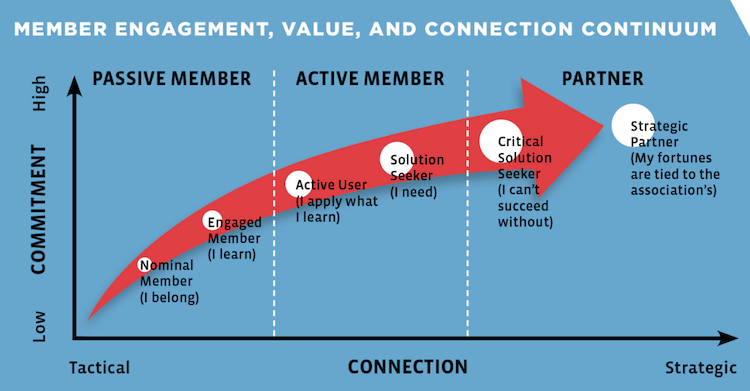Think of a club or organization that you are currently in, or used to be in. It could be a high school group, a college group, a hobby you do as a professional- anything.
Now, think of someone in that organization that is super excited and passionate about being there. Perhaps it is you, the club or organization leader, or just a super bubbly person who loves being involved. Smile as you appreciate that person and their enthusiasm that always seems to brighten your day.

Next, think of an individual who is a ‘good’ or highly involved member. It may be hard to pick just one. This individual enjoys being there, but also realizes that they have other things going on in their life besides this organization. They tend to make your involvement fun and meaningful, right?
Think of an individual in your group who really doesn’t want to be there. Think about their attitude, their nonverbal communication, and how you constantly question why attend meetings. Why did they decide to show up, anyway? You just thought of someone, didn’t you?! Almost every organization has at least a few passive members that come and go, they may not seem like they contribute much to the group.
If you’re part of a high functioning and strong organization, you may have a few members or even no members like the third individual I describe. And if you do, congratulations! You are part of an organization where most members want to be involved with everything and I hope you truly value that. Now if your organization experiencing a few bumps, this is okay too. Most organizations, especially student organizations, have members that join but don’t seem to contribute much.
Why are they even there? Do you ever wonder why they joined?
The Impact of Passive Members
We may not know or understand why they are there, but we do know the effects they can have on a group. There are three main concerns with passive members: morale, recruitment, and word of mouth.
Passive members can have a profound impact on the overall morale of an organization. Particularly when working with undergraduate students, we often see the “chameleon effect” where students pick up on the attitudes and behaviors of other students. While the chameleon effect can work in both good ways and bad ways, it unfortunately can allow students that may be trying an excuse to stop if they see others also not caring. It is a lot easier and quicker to discourage someone than to encourage them, and this is the negative chameleon effect that passive members can have on other group members.
Mixed messages of group morale can be confusing to members, especially if they’re new. Organizations want to keep morale as high as possible, so we want to create high expectations to help the group reach that goal.

Another concern with passive members is recruitment. If passive members are not engaged while in the heart and passion of the organization, they probably aren’t big supporters outside of the organization as well. In organizations, recruitment is just as important as retention, and recruitment is 24/7 regardless of the timing of your meetings or events.
Students talk with other students and tend to share their experiences, which leads us into word of mouth: if they don’t have much good to say within the organization, are they saying good things outside of the organization?
You Can Bring a Horse to Water…
You’ve heard the saying before: “you can bring a horse to water, but you can’t make it drink.”
Member engagement is a similar way: you can give plenty of opportunities to students, but that doesn’t mean they’ll engage. You can bring a horse to water, but you can’t make it drink: perhaps the horse isn’t thirsty. Maybe it’s hungry. Are we trying to force organization involvement onto a student instead of identifying the member’s expectations and wants?
Passive members can help your organization grow because they can show you that we sometimes assume what members need instead of asking them. Members cannot grow past passive engagement if they don’t feel the connection to the organization, and each passive member can teach us a new way to engage students as individuals and help them develop throughout their college career. If we focus on new ways to engage members to help them learn, their connection to the organization will automatically help them grow from passive members to active members.
My favorite visualization of this process is from The Center for Association Leadership (ASAE).

This continuum is one of the best ways to understand how to foster a member’s connection to their organization: once they belong, they learn, they apply what they learn, and they seek solutions until they can’t succeed without them.
If your students are passive members and never getting out of the passive member stage, they may not feel a strong connection to your organization. You can try to force the existing knowledge on them, but it doesn’t mean they’re ‘thirsty for water’. If you take the time to see what knowledge they want to learn, and determine their expectations and wants, then you can engage those members without disengaging others.
If you’ve noticed, I’ve never referenced passive members as ‘bad’ or necessarily negative members. They could be simply disengaged and disconnected, or considered unconventional from the rest of the organization. Also note that passive is not the same as introverted, which are individuals who process more internally than externally and gain energy from their internal world. Passive members don’t necessarily cause issues or trouble for your organization, they may be stuck and need a boost forward: think of the involvement idea as motivating the middle.
Let’s revisit the individual from your organization that who just really really didn’t’ want to be there. Did they really not want to be there, or did they not feel connected or pushed to learn for the organization? Did any leaders try to focus on meeting their needs instead of forcing the organization’s existing processes or knowledge on that individual?
Think about what would happen if we focused on these values from the beginning in each student organization. Passive members can teach you a lot about ways your organization can grow, so how are you helping your organization move forward while understanding what it takes to help them feel connected?
Share your thoughts and ideas with us @amanda_koslow & @checkimhere!
Thanks for reading ?





